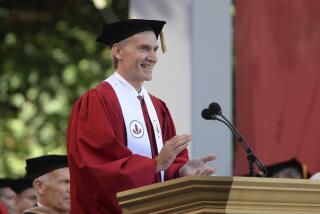Stanford’s Linear Accelerator Blazes Trail to the Future
- Share via
STANFORD — A fierce rivalry in the esoteric world of high-energy physics is drawing to a close, but not before scientists who have devoted years of their lives to a bold gamble claim at least a partial victory.
The Stanford Linear Accelerator will probably never live up to the full expectations of its creator, Nobel laureate Burton Richter, and in the months ahead the pleasure of announcing major developments in particle physics will go mostly to scientists at other facilities. But experts here last week said they have made their point: the Stanford accelerator, which collides beams of electrons and positrons to produce subatomic particles that existed at the birth of the universe, has pointed the way to the future.
Richter believes the technology developed here will lead to a new generation of atom smashers that will help scientists understand the beginning of time.
Physics in the 21st Century
The Stanford collider “has answered the question of how we are going to do physics in the next century,” Richter said during a major international symposium at Stanford University last week.
Richter and scores of others had gambled that they could produce a machine at a fraction of the cost of other atom smashers. But to succeed, it would have to operate on a level of precision that is almost unthinkable, despite the fact that much of it was built out of used parts.
The goal was to produce the Z particle, the so-called bearer of the weak force that allows atoms to decay into other atoms, releasing radioactivity. Richter had hoped to produce thousands. So far, he has made fewer than 250.
Meanwhile, the world’s largest accelerator is about to begin operating near Geneva, and no one here seriously doubts that the European Center for Particle Physics (CERN) will soon command center stage. That collider, which is of a conventional design and cost 10 times as much as Stanford’s, features a circular accelerator that wanders for 17 miles beneath farms and villages near Geneva.
Stanford won the race with CERN to become the first “Z factory,” but the Europeans will be the first to manufacture enough Zs to answer some of the most fundamental questions of physics.
“Our hope is we are taking over, but they are doing their best to keep that from happening,” physicist Friedrich Dydak of CERN said of Richter and his colleagues.
As if to underscore that point, physicists at the Stanford Linear Accelerator Center told about 600 scientists last week that the handful of Z particles they have captured have revealed that there are only three or four “families” of quarks and leptons in the subatomic world.
Quarks and leptons are the basic building blocks of matter. For more than a decade, scientists have been convinced that there are at least three families of quarks and leptons, and they could not rule out the possibility that there could be more.
But physicist Gary Feldman reported that evidence collected at the Stanford center has set an upper limit on the number of families in the subatomic world. “We can rule out that there are five or more families,” Feldman said.
The handful of Zs at Stanford also has allowed scientists to make a more precise measurement of the mass of the tiny particle. In the world of subatomic physics, mass is measured in electron volts. Stanford has established the mass of the Z at 91.17 billion electron volts, Feldman said.
Determining the mass is important because it will help scientists move a little closer to understanding the moment when the universe began, the so-called Big Bang. At that moment, scientists believe, there was only one force in nature that subsequently divided into four: gravity, electromagnetism, the strong force that binds atoms together and the weak force that allows them to decay. It is the latter force that is ruled by the Z particle and its cousin, the W.
By building larger and larger colliders, scientists hope to achieve energies sufficient to reproduce the moment when the universe began.
But big colliders command huge investments. The CERN collider was built at a cost of about $1.5 billion. The Super Collider that the U.S. government wants to build in Texas will cost at least $6 billion.
Some scientists regard Richter as the creator of the CERN collider because he proposed its design and construction more than a decade ago. But recognizing that the cost of high energy physics was getting out of hand, he returned to Stanford and launched the effort to build a new collider using an existing 2-mile long linear accelerator.
A “horseshoe” was added at one end of the 20-year-old accelerator. Beams of electrons and positrons are accelerated to nearly the speed of light and then bent in opposite directions around the horseshoe, colliding in a huge detector that records the debris from the collision.
Thinner Than a Hair
The colliding beams must be compressed to about 1/10th the thickness of a human hair, a demand that almost proved too difficult. But in the end, the system worked, even if not as well as Richter had hoped.
Its cost: about $120 million.
Even though CERN will be able to produce more Zs, there are some things that the Stanford collider will be able to do better. Because the colliding beams are so small, it is possible to move equipment much closer to the point of impact. That will allow scientists at the Stanford center to study particles that cease to exist almost as soon as they are created.
So while the bigger prizes may go to the Europeans, there will still be much for the Stanford facility to do.
“Now, we will go our separate ways,” Richter said.
But the fierce competition between CERN and Stanford, he conceded, is over.






